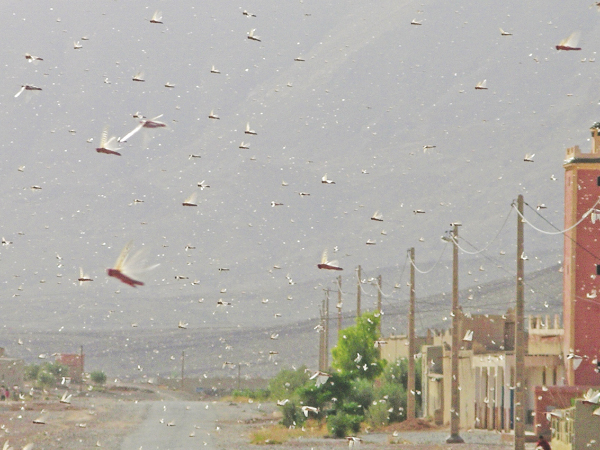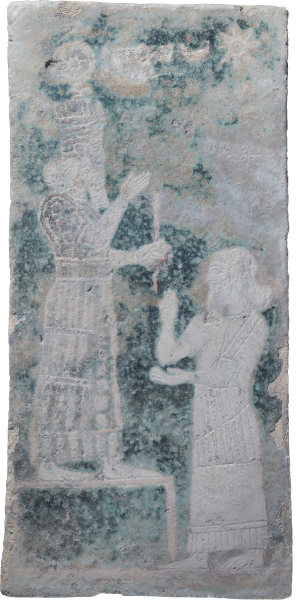Invasion of Locusts and a Call to Repentance (1:1–20)
Hear this (1:2). Appeals for an attentive audience are not unique to ancient Israelite literature. The goddess Inanna in the Sumerian epic Enmerkar and the Lord of Aratta encourages the hero, Enmerkar, to listen and take heed to her advice.3 The same is found in the Ugaritic myth Baal and Anat, where Sapsu calls out to Mot to listen to his words.4

Descent of Inanna text
The Schøyen Collection MS 3281, Oslo and London
Has anything like this ever happened? (1:2). Asking a rhetorical question concerning an unprecedented event occurs in Sumerian literature, in Dumuzi’s Dream (“Since time of yore, who ever saw a sister revealing the hiding place of her brother?”),5 in Inanna’s Descent (“Who ever saw a man find safety for his life in a house not his own?”),6 and in The Curse of Agade (“Who ever saw a king holding [his] head in [his] hands for all of seven years?”).7
Locusts (1:4). Since the locusts are compared to an army in 2:4–9, Joel is probably describing a real locust plague. The four pairs of locusts here and in Joel 2:25 appear by themselves or in pairs in other places in Scripture (e.g., Deut. 28:38; Isa. 33:4; Amos 7:1). Opinion is divided as to whether the four names for locusts in this section referred to different developmental phases or to different species. The migratory locust does not go through a metamorphosis as easily recognizable as a butterfly.8

Locust swarm in Morocco
Julio Era
The Assyrian hymn to the goddess Nanaya has interesting parallels with this verse: “The evil locust which destroys the crop/grain, the wicked dwarf-locust which dries up the orchards.”9 The hymn was apparently composed in response to a locust infestation during the time of Sargon II.10 Like Joel, the hymn lists at least two types of locusts, which appear to be distinct species and not developmental stages. In fact, over twenty words for locust have been found in Akkadian, one of the primary Semitic languages of Mesopotamia.11
A nation has invaded (1:6). The locusts here are described as a “nation.” Conversely, Sumerian, Ugaritic, Egyptian, and Assyrian literature occasionally compares human armies to locusts.12 The army of Keret in the Ugaritic Keret legend is said to be as numerous as locusts.13 Defeated enemies during the reigns of New Kingdom monarchs Rameses II (1279–1212 B.C.) and Merneptah (1212–1204 B.C.) in Egypt are often compared to locusts.14 Likewise, the Assyrian annals during the reigns of Sargon II and Sennacherib compare locusts to invading armies.15 Comparing bees, birds, and flies with a nation is also found in the Greek Iliad.16
Laid waste my vines and ruined my fig trees (1:7). A relief of Ashurbanipal of Assyria (668–627 B.C.) and his queen shows a locust on a palm tree, presumably preparing to devour the tree.17
The predominant locust in the ancient Near East was the desert locust.18 This locust is actually selective about its eating habits and searches out food based on smell and appearance. It chews a small portion of a plant and rejects or accepts it based on taste, usually feeding on natural vegetation. However, in cases of food shortage, the locust becomes less discriminate in its selection of food and will eat nonplant substances and even other locusts. For the most part, they will not eat carob and sycamore trees or castor and oleander bushes, and they will eat olive and date trees only after everything else is gone.
In 1915, there was a great locust plague in Israel, and the locusts flew in from the northeast to Jerusalem, providing a paradigm for the Joel locust invasion from the north.19
Sackcloth (1:8). Sackcloth (made of goat or camel hair) was worn in ancient Mesopotamia and elsewhere for mourning and as a visible representation of humiliation, as in Israel.20 Texts from Assyria during the reign of Esarhaddon (681–669 B.C.) describe the king as “taking off his royal dress and wrapping his body in sackcloth befitting a penitent sinner.”21 Moreover, Adad-Guppi, the mother of the Chaldean king Nabonidus (556–539 B.C.), writes in her fictional autobiography that she wore sackcloth in order to appease Sin, the moon god.22 The tenth century B.C. Ahiram sarcophagus from Byblos appears to present mourning females with sackcloth over their dresses.23
Grain offerings and the drink offerings are cut off from the house of the Lord (1:9). The phrase in the Nanaya hymn, “which cuts off the daily offerings of the gods and goddesses,” is remarkably similar to this passage in Joel.24 Both passages bemoan the fact that the locust plague has impeded the sacrificial offerings, which were fundamental to the life of the spiritual community.
Fields are ruined (1:10–12). Many incidents concerning the destruction of fields and orchards are noted in annals of the Neo-Assyrian kings of Mesopotamia.25 These acts of destruction were usually done by the Assyrians themselves on enemy trees, canals, and meadows, all of which were vital to the existence of states in this dry desert region. Thus, Assyrian attacks often crippled the economy of an enemy state, as it took years for a fruit tree to grow to maturity (as much as twenty years for a date palm). Moreover, the ecological devastation wrought by the invasion often reduced fertility. In fact, the destruction of an enemy’s fruit trees was often an effective way of causing the surrender of a fortified town, which was susceptible to starvation. The locusts are thus likened to an invading army that destroys the economy of the land.
Cry out to the Lord (1:14). It was common in the ancient Near East to see locust plagues as having been sent from a deity, so the natural response was to pray for the removal of the plague. A relief from the period of Sargon II of Assyria (721–705 B.C.) has a person with a locust above his head in front of the deity Shamash, presumably to placate the god for the removal of a plague or to give thanksgiving for deliverance from a plague.26 Furthermore, the Assyrians and Babylonians employed magical incantations and omens to avert locust plagues. One Assyrian omen states, “If the inner side of the liver is curved at the spot (which indicates) devastation by locusts, there will be pestilence in the prince’s country.”27 Though the Israelites did not use incantations and omens, they certainly did pray for relief from natural disasters such as locust plagues.

Sargon II relief has a person on the right standing before Shamash, presumably to placate the god for the removal of a locust plague or to give thanksgiving for deliverance from it. Note the locust above the worshiper’s head (large, but barely visible across from the eyes of the deity).
Bildarchiv Preussischer Kulturbesitz/Art Resource, NY, Vorderasiatisches Museum, Staatliche Museen zu Berlin